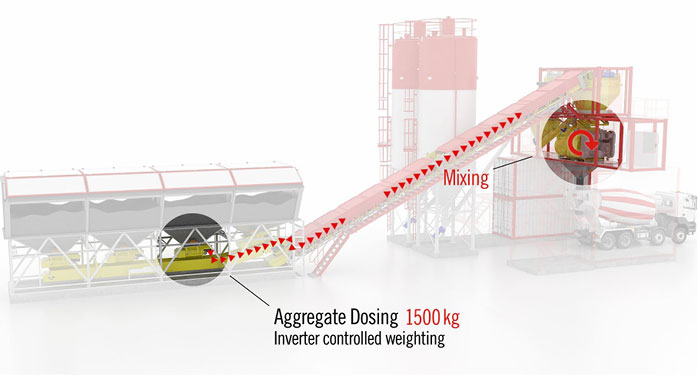
Before concrete production starts, aggregate dosing equipment is dosing all aggregates onto the weighing belt. However, the amounts dosed normally differ quite a lot from what should have been dosed.
These variations in dosing lead to a concrete mixture not being according to the original mix design. To avoid a reduced concrete strength the variations are compensated by adding extra cement. In some cases up to 30 kilo per cubic metre of concrete are added! This is not necessary, just use an optimized dosing and weighing system! Find out how to decrease the amount of cement and by this save a lot of money:
Generally concrete, with an appropriate equipment, can easily be produced; aggregates, binding agents, water and probably admixtures just need to be mixed. Cement is an important ingredient to strengthen the concrete. However, it is important to not add more cement than required.
Cement should only be dosed with the necessary quantity, because it is the most expensive raw material in a concrete mix and too much cement also may cause problems in matters of concrete quality. In addition cement production is quite environmentally unfriendly, generating a huge amount of CO2 emissions, another reason to reduce cement consumption as much as possible.
Variation because of the inaccurate working dosing equipment
Inaccurate working dosing equipment of a concrete mixing plant causes high variation and leads to quality problems. Therefore load cells and scales with an accuracy of 1 gram are not enough, the problem is the dosing equipment and the big deviation. When dosing equipment feeds the material to the weighing scale, the material flow is not constant as it depends on many factors. This is the same, no matter whether aggregates, binding agents or fluids are concerned.
Especially the material flow from aggregate dosing gates or belt feeder often causes major problems. Flow speed not only depends on the fraction and moisture of the aggregates, but also on the gate construction and the timing of the open/close respectively start/stop functions.
Undefined flow in connection with inaccurate and unreliable moisture measuring lead to noteworthy differences in the amount of aggregates and water in a mixture!
Concrete standards allow up to 2% deviation in aggregate dosage, which e. g. in a 2 m3 batch containing 3,700 kg aggregates results in a deviation of up to +/- 74 kg.
To compensate the variation in aggregate dosage and with this the amount of water contained in the aggregates, very often 5 up to 30 kg/m³ “extra” cement is added with the concrete mix design. This only to be on the safe side, concrete strength wise.
Normally cement is needed in a quantity of 10 kg/m3 x MPa.
How to avoid the “extra cement” and with this save a lot money?
Here is the solution!
Tecwill has invented a new technology of dynamic aggregate dosing and weighing, called the “flying” aggregate dosing and weighing system.
The aim was to precisely dose only the amount of aggregate as noted in the mix design, with the lowest possible deviation. One secret of this “flying” system is using frequency controlled dosing devices and one other secret is the special construction of the dosing equipment.
With this it is possible to reduce the variation in dosing of aggregates to an absolute minimum. At the same time the water contained in the aggregates can be calculated more precisely.
In addition, if a moisture measuring system is used that works accurately and can be handled easily, the required amount of additional water can always be defined exactly.
If so, there is no need of having to additionally control the amount of water in the mixer by sensors or trying to produce constant mixtures by watching the kW power meter.
Exact dosing and weighing, precise measuring of aggregate moisture and no need of additional measuring in the mixer, these factors are reducing the weighing and mixing times and lead to an increased production capacity.
Cement dosing can be optimized if a basic cement screw gets equipped with a frequency controlled motor.
Minimizing the deviation in weighing, especially of the aggregates, will generate huge savings because there is no further need to compensate inaccurate dosing by adding ”extra” cement.
Let’s say that it is possible to save on average 20 kg of cement per m³ concrete, we are talking about quite a big amount of money. With a yearly concrete production of 50,000 m³, 1,000 tons of cement per year could be saved.
Conclusion
Forget the maximum %-value of dosing accuracy in concrete standards or load cell accuracy-%!
You can do it much better, by this saving cement and additionally getting remarkable benefits with your concrete production.
We are going to provide further information concerning this issue in future blogs, due to the fact that accuracy in concrete production and possibilities to reduce costs are very important and actual topics.
Read more about ready-mix concrete plant functionalities >
Please contact us, if you are interested in finding out more about how to save cement and money by using Tecwill’s revolutionary “flying” dosing and weighing system.

